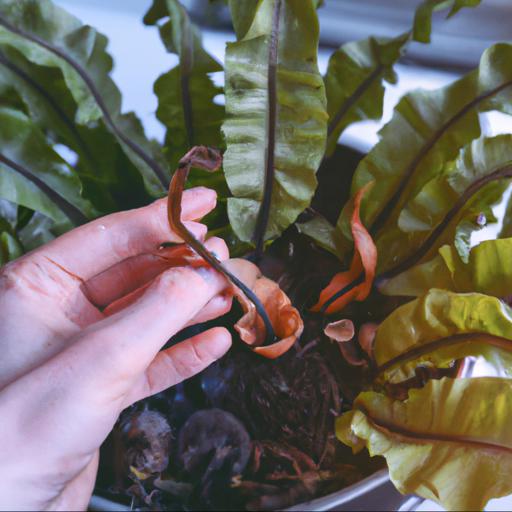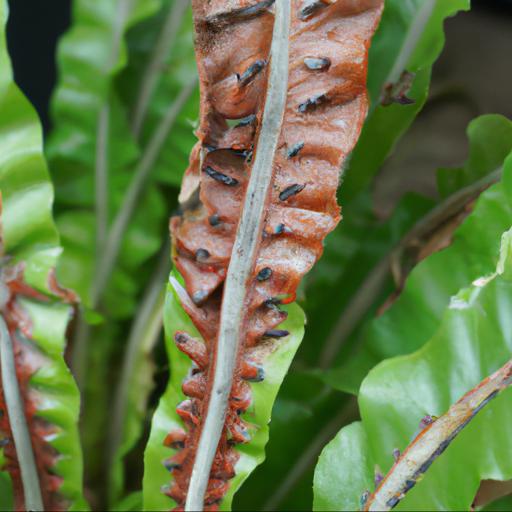Asplenium scolopendrium, commonly known as Hart’s tongue fern, is a species of fern native to Europe, Asia, and North Africa. It is an evergreen, perennial plant that grows in shady, moist areas and is often found in woodlands and on rocky slopes.
The fronds of the Hart’s tongue fern are dark green, leathery and have a tongue-shaped appearance. This fern is a popular choice for gardens, as it is easy to care for and requires minimal maintenance. In this blog, we will explore the unique features of Asplenium scolopendrium, and discuss how to care for it in the garden.
We will also look at the benefits of having this fern in your garden, and how it can be used to add a touch of greenery and beauty to your outdoor space.
Benefits of asplenium scolopendrium

Asplenium scolopendrium is a species of fern that is known for its many benefits. Native to Europe, this robust fern has many active compounds that make it one of the greatest British garden assets and one of the best medicinal herbs.
Here are some of the ways you can benefit from Asplenium scolopendrium in your garden. One benefit of Asplenium scolopendrium is its ability to create a lush, green landscape. This fern is an evergreen, meaning that it is always in-season in the UK gardens.
No matter the time of year, Asplenium scolopendrium will bring life to your yard with its bright green fronds. Additionally, its perennial nature allows it to provide a reliable source of beauty over multiple years and seasons.
Aside from its aesthetically pleasing qualities, Asplenium scolopendrium has many medicinal properties that are beneficial to the soil, plants and even people. This fern is rich in antioxidants including vitamin C, which helps improve the quality of the soil and provide protection to the local ecosystem. It is also known to have anti-inflammatory, antiviral and antibacterial qualities, which makes it a powerful protector against many of the common garden illnesses.
Finally, Asplenium scolopendrium is an affordable and easy-to-maintain garden accessory. Once planted, this fern requires very little attention and maintenance, so it is ideal for novice gardeners or busy individuals who want to add some greenery to their yard without devoting a lot of time or resources.
Its hardy nature and low maintenance requirements mean that it can thrive in a variety of soil and climate conditions, making it a great addition to almost any garden. In sum, Asplenium scolopendrium is an invaluable fern for any British garden. Not only does it provide a beautiful backdrop and aesthetic, but it also offers a range of medicinal benefits, from protecting the surrounding environment to providing natural remedies.
Lastly, this hardy fern requires minimal maintenance and is incredibly affordable, so it is a great addition to any UK garden.
Growing and caring for asplenium scolopendrium

Asplenium scolopendrium, also known as Hart’s Tongue Fern, is a species of fern native to much of the Northern Hemisphere. Its hardy nature makes it a favourite of many gardeners, particularly UK gardeners, due to its resistance to both cold temperatures and changes in humidity.
This species of fern is incredibly low maintenance and requires virtually no care whatsoever in order to look at its best. The Hart’s Tongue Fern is an evergreen fern meaning it retains its foliage all year round, and can be found on woodland floors and shady areas of shady gardens. This plant does not require much sunlight and loves growing in moist yet well-drained soil.
An abundance of organic matter and a high level of humidity promotes optimal growth for the Asplenium scolopendrium. Its leaves are a distinct shape, shaped like a tongue and a dark green in colour. This evergreen fern has a long rooting system and is often found covering embankments and rocks when grown in the wild.
In terms of watering, the Hart’s Tongue Fern requires regular but minimal water. It thrives in humid environments but can be easily damaged by over-watering.
This species of fern is also very susceptible to a number of common garden pests, including slugs and snails, and if unchecked can be a source of damage to the plant. The Asplenium scolopendrium reproduces via spores rather than seed, and the spores can be easily collected and harvested for propagation, making this an easy plant to maintain in your garden.
In conclusion, the Asplenium scolopendrium is an ideal plant for those who value easy maintenance and hardy evergreens in their landscape. It is low-maintenance and can withstand cold temperatures and changes in humidity. With its distinct leaves and low-maintenance nature, the Hart’s Tongue Fern is a popular choice among many UK gardeners and can make a great addition to any outdoor environment.
Common problems with asplenium scolopendrium

As a UK garden expert, I know all too well of the common problems that come with growing Asplenium scolopendrium, or Hart’s Tongue Fern. This evergreen fern is native to the UK and is a hardy species, however, there are still some common problems with it. The most common problem facing people trying to grow Hart’s Tongue Fern is keeping it in the right environment.
This fern prefers areas with moisture and shade, so depending on where in the UK you’re trying to grow it, you may have to keep it artificially moist and shaded. If grown in the wrong environment, the fern can start to yellow, loose its bright green colour, and its fronds can become brittle and weak.
As such, it’s important to pay attention to the adaptation of the plant’s environment, and find a balance between sun and shade that’s best for this particular fern. Another common problem for Hart’s Tongue Fern is pests, such as slugs and snails.
As these pests feed on the fronds of the fern, it will be necessary to treat these common garden pests in the vicinity of the fern in order to stop the damage to the plant. There are many different solutions to this issue, such as using powdered iron sulphate on the fronds, or, for more natural solutions, setting out a shallow bowl of beer and placing it near the fern. The slugs and snails will be drawn to the beer and be trapped in the bowl, thus keeping the fern safe from further consumption.
Finally, for those wishing to propagate their Hart’s Tongue Fern, it can be tricky to know when the time is right. This fern propagates by spore, not by divisions, and so you will have to be patient and wait until the correct time of year when the fronds produce spores. At this point, it’s a matter of collecting the spores in small paper bags and being careful not to let them dry out, or touch the frond itself, as the spores can easily be lost.
In summary, Asplenium scolopendrium, or Hart’s Tongue Fern, is a hardy UK native fern, however, it can still present some common problems. It’s important to supply the correct environment and take precautions against pests, and when it comes to propagation, patience and care are key.
Our video recommendation
Conclusion
Asplenium scolopendrium, commonly known as Hart’s-tongue fern, is a species of fern native to Europe, North Africa, and parts of Asia. It is a hardy, evergreen fern that grows in shady, damp, and nutrient-rich soils. Its fronds are long, narrow, and dark green in color, and the sori are located on the underside of the fronds.
Asplenium scolopendrium is an easy to grow and maintain fern that is ideal for adding texture and color to shady gardens.
FAQ
What is the scientific name of Asplenium scolopendrium?
The scientific name of Asplenium scolopendrium is Asplenium scolopendrium.
What are the common names of Asplenium scolopendrium?
The common names of Asplenium scolopendrium are Hart’s-tongue fern, Hart’s-tongue, and Common Hart’s-tongue.
Where is Asplenium scolopendrium found?
Asplenium scolopendrium is found in moist, shady areas of Europe, Asia, and North America.
What are the characteristics of Asplenium scolopendrium?
Asplenium scolopendrium is a species of fern with long, dark green, leathery fronds. It is a hardy, evergreen perennial that can tolerate a range of soil types and is drought tolerant. It is a slow-growing plant that prefers partial shade and moist, well-drained soil. It has a rhizomatous root system and produces spores for reproduction.
How is Asplenium scolopendrium used in traditional medicine?
Asplenium scolopendrium has traditionally been used in herbal medicine as a diuretic, to treat respiratory ailments, and to reduce inflammation.
What are the benefits of Asplenium scolopendrium?
The benefits of Asplenium scolopendrium include its ability to purify air, reduce stress, improve sleep quality, and boost immunity. It is also known to have anti-inflammatory and antioxidant properties, as well as being a natural insect repellent.

